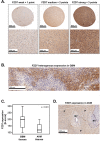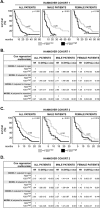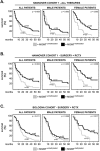Sex-specific clinicopathological significance of novel (Frizzled-7) and established (MGMT, IDH1) biomarkers in glioblastoma
- PMID: 27409829
- PMCID: PMC5342409
- DOI: 10.18632/oncotarget.10465
Sex-specific clinicopathological significance of novel (Frizzled-7) and established (MGMT, IDH1) biomarkers in glioblastoma
Abstract
Background: The Wnt receptor Frizzled-7 (FZD7) promotes tumor progression and can be currently targeted by monoclonal antibody therapy. Here, we determined the prognostic value of FZD7 for the overall survival of glioblastoma (GBM) patients, both as individual marker and taken in combination with the previously-described markers MGMT and IDH1. Additionally, we tested whether these markers (alone or in combination) exhibited sex-specific differences.
Results: High levels of FZD7 (FZD7high) associated with shorter survival in GBM patients; however, FZD7high was a significant predictor of poor survival only in male patients. Mutation of IDH1 significantly associated with longer survival in male but not female patients. Methylated MGMT promoter significantly associated with longer survival only in female patients. Combination of FZD7 with MGMT enhanced the prognostic accuracy and abrogated the sex differences observed upon single marker analysis. Combination of FZD7 with IDH1 was a significant predictor of survival in male GBM patients only.
Materials and methods: Three independent cohorts of patients with primary GBM (n=120, n=108 and n=105, respectively) were included in this study. FZD7 and IDH1 were assessed by immunohistochemistry in tissue microarrays. MGMT promoter methylation was determined by methylation-specific polymerase chain reaction. Survival analysis was performed by Kaplan-Meier estimate, log-rank test and Cox proportional hazard regression.
Conclusions: Our study identifies novel individual and combination markers with prognostic and, possibly, therapeutic relevance in GBM. Furthermore, our findings substantiate the importance of sexual dimorphism in this type of cancer.
Keywords: Frizzled-7; IDH1; MGMT; glioblastoma; sex-specific biomarkers.
Conflict of interest statement
The authors have no conflict of interest to declare.
Figures





References
-
- Adamson C, Kanu OO, Mehta AI, Di C, Lin N, Mattox AK, Bigner DD. Glioblastoma multiforme: a review of where we have been and where we are going. Expert Opin Investig Drugs. 2009;18:1061–1083. - PubMed
-
- Stupp R, Mason WP, van den Bent MJ, Weller M, Fisher B, Taphoorn MJ, Belanger K, Brandes AA, Marosi C, Bogdahn U, Curschmann J, Janzer RC, Ludwin SK, et al. Radiotherapy plus concomitant and adjuvant temozolomide for glioblastoma. N Engl J Med. 2005;352:987–996. - PubMed
MeSH terms
Substances
LinkOut - more resources
Full Text Sources
Other Literature Sources
Medical
Research Materials
Miscellaneous

